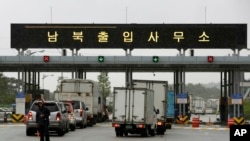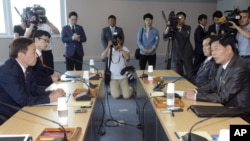SEOUL —
Negotiators from North and South Korea are meeting for a fourth round of talks July 17 with little progress so far in restarting the jointly invested Kaesong industrial complex. The factory park is the last remaining symbol of inter-Korean cooperation and analysts say a failure to reopen it would increase tensions in already fractured relations.
Working level talks got off to a positive start earlier this month with both sides agreeing in principle to re-open their shuttered joint industrial complex.
Pyongyang also allowed South Korean factory managers to inspect equipment in the Kaesong factory park, just over the border in North Korea, and remove raw materials.
But, as many predicted, negotiations to re-start production after the three month suspension quickly bogged down on key issues.
Pyongyang wants to immediately reopen the factories while Seoul wants guarantees the North will never again unilaterally suspend operations.
Lim Eul-chul, a professor of North Korean studies at Kyungnam University, said if the complex is closed permanently due to the failure of the talks, there would be nothing left between the two Koreas as there is no other traffic, contact, trade or economic cooperation. Therefore, he said, the uncertainty of inter-Korean relations would increase and military tensions would also be heightened.
The factories have been shut since April when Pyongyang withdrew its 53,000 workers. South Korean factory managers left the following month.
North Korea blamed the shutdown on South Korea for what it said were insults to its dignity and increased tensions from annual South Korea-United States military exercises.
Pyongyang was responding to tighter United Nations sanctions for launching a rocket in December and in February conducting its third, and largest, nuclear test.
Besides a guarantee from the North to keep Kaesong open, Seoul also wants Pyongyang to allow international investment in Kaesong to better ensure stable operations.
Lim Eul-chul said Pyongyang has shown no interest in involving outside investors.
He said North Korea does not want to give the benefits to foreign companies so it is difficult for them to join the complex. However, he said if they did agree it would likely be Chinese companies invited first followed by European companies.
He said China cooperates and has exchanges with North Korea and the two Koreas consider Europe more flexible on the issue of sanctions imposed by the international community.
Kaesong opened in 2004 as part of former South Korean President Kim Dae-jung's engagement and aid to North Korea, known as the “Sunshine Policy.”
The factory zone kept running through periods of high tensions. Production continued in 2010 when a North Korean torpedo was blamed for sinking a South Korean Navy ship, killing 46 sailors, and Pyongyang shelled a southern island, killing four people.
The Kaesong complex suspension has cost South Korean businesses and the North Korean government hundreds of millions of dollars in lost revenue.
Nonetheless, North Korean Studies professor Kim Yong-hyun of Dongguk University said the gap between the two Korea's positions will be tough to narrow.
He said changes outside of the Korean peninsula, such as the resumption of six-party talks, the efforts of the United States and China, and pressure from the international community would make the normalization of Kaesong industrial complex possible. If the external environment is improved, he said, it would have a positive effect on normalizing the Kaesong complex as well as on inter-Korean relations.
North Korea abandoned stalled six-party talks in 2009 aimed at negotiating an end to its nuclear ambitions.
Pyongyang's veteran nuclear negotiator last month told Chinese officials the North was willing to re-engage in the talks with China, Japan, Russia, South Korea and the United States.
But, South Korea and the U.S. say they need to first see actions by North Korea to demonstrate it is serious about giving up its nuclear programs.
VOA Seoul Bureau producer Youmi Kim contributed to this report.
Working level talks got off to a positive start earlier this month with both sides agreeing in principle to re-open their shuttered joint industrial complex.
Pyongyang also allowed South Korean factory managers to inspect equipment in the Kaesong factory park, just over the border in North Korea, and remove raw materials.
But, as many predicted, negotiations to re-start production after the three month suspension quickly bogged down on key issues.
Pyongyang wants to immediately reopen the factories while Seoul wants guarantees the North will never again unilaterally suspend operations.
Lim Eul-chul, a professor of North Korean studies at Kyungnam University, said if the complex is closed permanently due to the failure of the talks, there would be nothing left between the two Koreas as there is no other traffic, contact, trade or economic cooperation. Therefore, he said, the uncertainty of inter-Korean relations would increase and military tensions would also be heightened.
The factories have been shut since April when Pyongyang withdrew its 53,000 workers. South Korean factory managers left the following month.
North Korea blamed the shutdown on South Korea for what it said were insults to its dignity and increased tensions from annual South Korea-United States military exercises.
Pyongyang was responding to tighter United Nations sanctions for launching a rocket in December and in February conducting its third, and largest, nuclear test.
Kaesong Joint Industrial Complex
Kaesong Joint Industrial Complex
-Started producing goods in 2004
-Employs about 53,000 North Koreans
-120 South Korean businesses operate there
-Hailed as rare example of North/South cooperation
-Generates $2 billion in trade annually for North
-Located 10 kilometers north of border
Lim Eul-chul said Pyongyang has shown no interest in involving outside investors.
He said North Korea does not want to give the benefits to foreign companies so it is difficult for them to join the complex. However, he said if they did agree it would likely be Chinese companies invited first followed by European companies.
He said China cooperates and has exchanges with North Korea and the two Koreas consider Europe more flexible on the issue of sanctions imposed by the international community.
Kaesong opened in 2004 as part of former South Korean President Kim Dae-jung's engagement and aid to North Korea, known as the “Sunshine Policy.”
The factory zone kept running through periods of high tensions. Production continued in 2010 when a North Korean torpedo was blamed for sinking a South Korean Navy ship, killing 46 sailors, and Pyongyang shelled a southern island, killing four people.
The Kaesong complex suspension has cost South Korean businesses and the North Korean government hundreds of millions of dollars in lost revenue.
Nonetheless, North Korean Studies professor Kim Yong-hyun of Dongguk University said the gap between the two Korea's positions will be tough to narrow.
He said changes outside of the Korean peninsula, such as the resumption of six-party talks, the efforts of the United States and China, and pressure from the international community would make the normalization of Kaesong industrial complex possible. If the external environment is improved, he said, it would have a positive effect on normalizing the Kaesong complex as well as on inter-Korean relations.
North Korea abandoned stalled six-party talks in 2009 aimed at negotiating an end to its nuclear ambitions.
Pyongyang's veteran nuclear negotiator last month told Chinese officials the North was willing to re-engage in the talks with China, Japan, Russia, South Korea and the United States.
But, South Korea and the U.S. say they need to first see actions by North Korea to demonstrate it is serious about giving up its nuclear programs.
VOA Seoul Bureau producer Youmi Kim contributed to this report.










